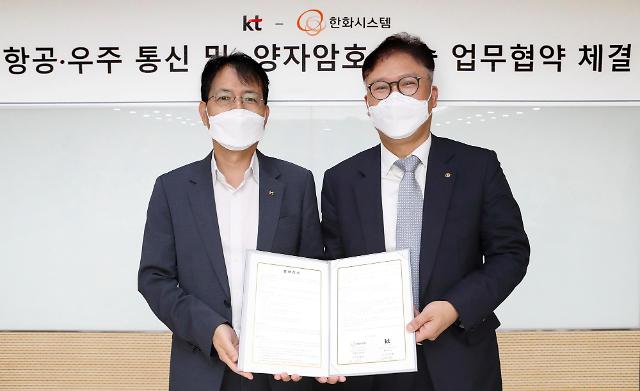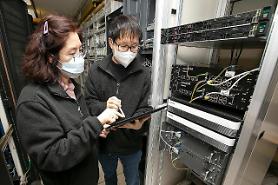
[Courtesy of KT]
SEOUL -- KT tied up with Hanwha Systems, a defense contractor affiliated with South Korea's Hanwha Group, to develop and promote the commercialization of laser-based wireless quantum cryptography communication for aviation and space in the 6G era. Wireless quantum cryptography communication is stable and secure.
Laser communication offers very high data rates, small antennas and privacy. Wireless quantum cryptography communication can be applied to future industries such as low-orbit satellite communication, autonomous driving, urban air mobility (UAM), an ecosystem covering personal air vehicles and infrastructure, as well as national security systems.
KT's quantum cryptography technology will be combined with Hanwha Systems' precise pointing, acquisition and tracking (PAT) system that accurately tracks the location of communication satellites moving at very high speeds in low orbit. They would establish a quantum cryptographic network between each company's research institute.
"Wireless quantum cryptography communication technology is a key technology requirement for KT to prepare for the 6G era, including satellite communication," KT's convergence technology lab head Kim Yi-han said in a statement on July 12.
By securing wireless quantum cryptography communication technology for aviation and space, stable security communication can be provided in mountains, seas, and air as well as remote areas, KT said, adding it would lay the foundation for satellite communication security services.
Quantum cryptography has emerged as an essential solution for safeguarding critical information because it is impossible to copy data encoded in a quantum state. Researchers have tried to find a new method of integrating quantum cryptography for wireless networks. KT has succeeded in short-distance wireless quantum cryptography transmission.
Through cooperation with KT, Hanwha Systems can secure the safety and security of satellite communication businesses. "Wireless quantum cryptography communication technology can be applied to defense, satellites and UAM where security and safety are essential," said Kim Jung-ho, head of Hanwha Systems' command and control business division. Hanwha Systems is a key member of UAM Team Korea, a public-private consultative body that would commercialize drone taxis in 2025.
Hanwha Systems aims to develop laser inter-satellite links (ISL), an essential technology for implementing communication services through low-orbit satellites. Low earth orbit satellite antenna provides broadband connectivity from satellites. Space Internet technology can offer high-quality wireless internet services.
Hanwha Systems plays a key role in South Korea's national goal of producing small low-orbit satellites weighing under 100 kilograms. The company has localized key components to lighten the payload of the midsized satellite. Light payloads will allow multiple satellites to be loaded into one projectile and create a cluster of satellites that can be connected to provide an integrated communication system and exchange observational information.
Copyright ⓒ Aju Press All rights reserved.



